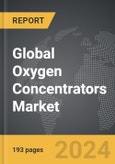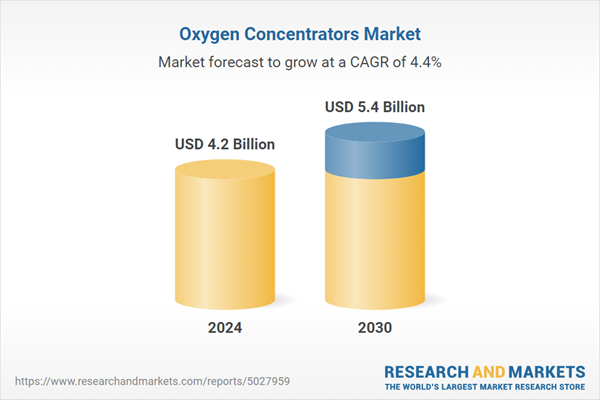The global market for Oxygen Concentrators was valued at USD 4.2 Billion in 2024 and is projected to reach USD 5.4 Billion by 2030, growing at a CAGR of 4.4% from 2024 to 2030. This comprehensive report provides an in-depth analysis of market trends, drivers, and forecasts, helping you make informed business decisions.
Global Oxygen Concentrators Market - Key Trends & Drivers Summarized
What Are Oxygen Concentrators, and Why Are They Essential in Healthcare?
Oxygen concentrators are medical devices that extract oxygen from the surrounding air and deliver concentrated oxygen to patients who suffer from respiratory conditions such as chronic obstructive pulmonary disease (COPD), pneumonia, asthma, and other lung disorders. These devices are designed to provide a continuous and reliable supply of oxygen therapy, which helps improve patients' breathing and overall quality of life. Unlike traditional oxygen tanks, which require frequent refilling, oxygen concentrators draw in ambient air, remove nitrogen, and deliver a high concentration of oxygen directly to the patient. Oxygen concentrators are vital in both homecare and hospital settings, especially for patients requiring long-term oxygen therapy. With the increasing prevalence of respiratory diseases worldwide, driven by aging populations, pollution, and smoking, oxygen concentrators have become essential in modern healthcare.How Are Technological Advancements Shaping the Oxygen Concentrator Market?
Technological advancements in oxygen concentrator design and functionality are significantly improving the efficiency, portability, and user experience of these devices. The development of lightweight and portable oxygen concentrators has made it easier for patients to maintain mobility and independence while receiving oxygen therapy. These portable models are equipped with rechargeable batteries, making them suitable for travel and outdoor activities. Additionally, innovations in noise reduction technology have made oxygen concentrators quieter, improving patient comfort, especially during nighttime use. Enhanced energy efficiency is another key advancement, with newer models consuming less power while providing higher oxygen output. Digital interfaces and smart technology integration are allowing patients and caregivers to monitor oxygen levels, device performance, and battery status in real time, offering greater control and safety. Telemedicine integration is also emerging, enabling remote monitoring of oxygen therapy, which is particularly valuable for patients in rural or underserved areas.Where Are Oxygen Concentrators Most Widely Used?
Oxygen concentrators are widely used in hospitals, homecare settings, and long-term care facilities. In hospitals, they are used to treat patients with acute respiratory conditions, such as pneumonia or COVID-19, where oxygen therapy is critical for recovery. Homecare is another major application area, where oxygen concentrators are used by patients with chronic respiratory diseases like COPD, who require ongoing oxygen therapy to maintain their oxygen saturation levels. The increasing preference for home-based healthcare, particularly among the elderly, has driven demand for portable and user-friendly oxygen concentrators. Long-term care facilities also rely on these devices to provide continuous oxygen therapy for residents with chronic health conditions. With the growing need for oxygen therapy across various healthcare settings, oxygen concentrators are becoming an indispensable tool in respiratory care, particularly in managing chronic and age-related lung diseases.What Is Driving the Growth of the Oxygen Concentrators Market?
The growth in the oxygen concentrators market is driven by several factors, including the increasing prevalence of respiratory diseases, advancements in portable medical technology, and the growing demand for home-based healthcare. One of the primary drivers is the rising incidence of chronic respiratory conditions such as COPD, asthma, and lung cancer, which require long-term oxygen therapy to manage symptoms and improve patients' quality of life. The aging global population is another significant factor, as elderly individuals are more prone to respiratory issues and are the primary users of oxygen concentrators. The recent COVID-19 pandemic has further highlighted the importance of oxygen therapy in managing severe respiratory infections, boosting the demand for oxygen concentrators in both hospital and homecare settings. Additionally, technological advancements, such as the development of lightweight, portable, and energy-efficient concentrators, are making these devices more accessible and convenient for patients. The shift toward home-based healthcare, driven by cost-effectiveness and patient preference for receiving treatment in a familiar environment, is further propelling market growth. Lastly, government initiatives to improve healthcare access and expand oxygen therapy availability in rural and underserved areas are contributing to the increased adoption of oxygen concentrators globally.Report Scope
The report analyzes the Oxygen Concentrators market, presented in terms of market value (USD Thousand). The analysis covers the key segments and geographic regions outlined below.Segments
Product Type (Portable Oxygen Concentrators, Fixed Oxygen Concentrators); Technology (Continuous Flow, Pulse Dose); Application (Non-Home Care, Home Care).Geographic Regions/Countries
World; United States; Canada; Japan; China; Europe (France; Germany; Italy; United Kingdom; and Rest of Europe); Asia-Pacific; Rest of World.Key Insights:
- Market Growth: Understand the significant growth trajectory of the Portable Oxygen Concentrators segment, which is expected to reach $3.5 Billion by 2030 with a CAGR of a 5.7%. The Fixed Oxygen Concentrators segment is also set to grow at 2.2% CAGR over the analysis period.
- Regional Analysis: Gain insights into the U.S. market, valued at $1.1 Billion in 2024, and China, forecasted to grow at an impressive 4.1% CAGR to reach $851.5 Million by 2030. Discover growth trends in other key regions, including Japan, Canada, Germany, and the Asia-Pacific.
Report Features:
- Comprehensive Market Data: Independent analysis of annual sales and market forecasts in USD from 2024 to 2030.
- In-Depth Regional Analysis: Detailed insights into key markets, including the U.S., China, Japan, Canada, Europe, Asia-Pacific, Latin America, Middle East, and Africa.
- Company Profiles: Coverage of major players such as Chart Industries, Inc., DeVilbiss Healthcare LLC, Inogen, Inc., Invacare Corporation, Medtronic PLC and more.
- Complimentary Updates: Receive free report updates for one year to keep you informed of the latest market developments.
Why You Should Buy This Report:
- Detailed Market Analysis: Access a thorough analysis of the Global Oxygen Concentrators Market, covering all major geographic regions and market segments.
- Competitive Insights: Get an overview of the competitive landscape, including the market presence of major players across different geographies.
- Future Trends and Drivers: Understand the key trends and drivers shaping the future of the Global Oxygen Concentrators Market.
- Actionable Insights: Benefit from actionable insights that can help you identify new revenue opportunities and make strategic business decisions.
Key Questions Answered:
- How is the Global Oxygen Concentrators Market expected to evolve by 2030?
- What are the main drivers and restraints affecting the market?
- Which market segments will grow the most over the forecast period?
- How will market shares for different regions and segments change by 2030?
- Who are the leading players in the market, and what are their prospects?
Some of the 43 major companies featured in this Oxygen Concentrators market report include:
- Chart Industries, Inc.
- DeVilbiss Healthcare LLC
- Inogen, Inc.
- Invacare Corporation
- Medtronic PLC
- Nidek Medical Products, Inc.
- O2 Concepts, LLC
- Philips Healthcare
- Teijin Ltd.
Table of Contents
I. METHODOLOGYII. EXECUTIVE SUMMARY2. FOCUS ON SELECT PLAYERSIII. MARKET ANALYSISREST OF WORLDIV. COMPETITION
1. MARKET OVERVIEW
3. MARKET TRENDS & DRIVERS
4. GLOBAL MARKET PERSPECTIVE
UNITED STATES
CANADA
JAPAN
CHINA
EUROPE
FRANCE
GERMANY
ITALY
UNITED KINGDOM
REST OF EUROPE
ASIA-PACIFIC
Companies Mentioned (Partial List)
A selection of companies mentioned in this report includes, but is not limited to:
- Chart Industries, Inc.
- DeVilbiss Healthcare LLC
- Inogen, Inc.
- Invacare Corporation
- Medtronic PLC
- Nidek Medical Products, Inc.
- O2 Concepts, LLC
- Philips Healthcare
- Teijin Ltd.
Table Information
| Report Attribute | Details |
|---|---|
| No. of Pages | 193 |
| Published | April 2025 |
| Forecast Period | 2024 - 2030 |
| Estimated Market Value ( USD | $ 4.2 Billion |
| Forecasted Market Value ( USD | $ 5.4 Billion |
| Compound Annual Growth Rate | 4.4% |
| Regions Covered | Global |









